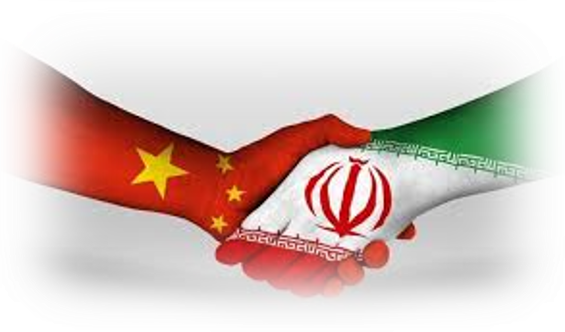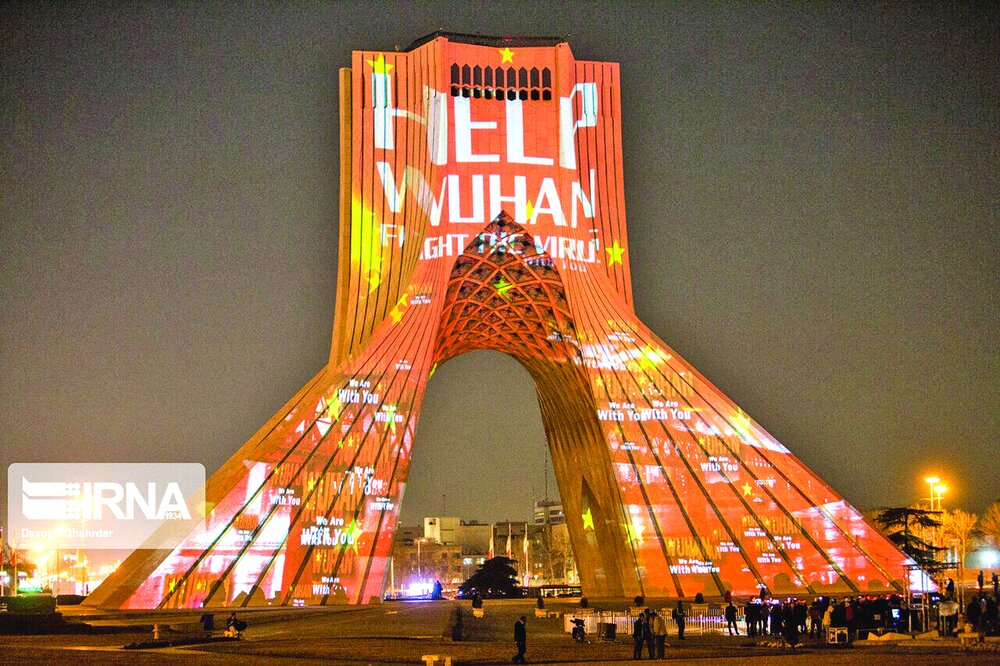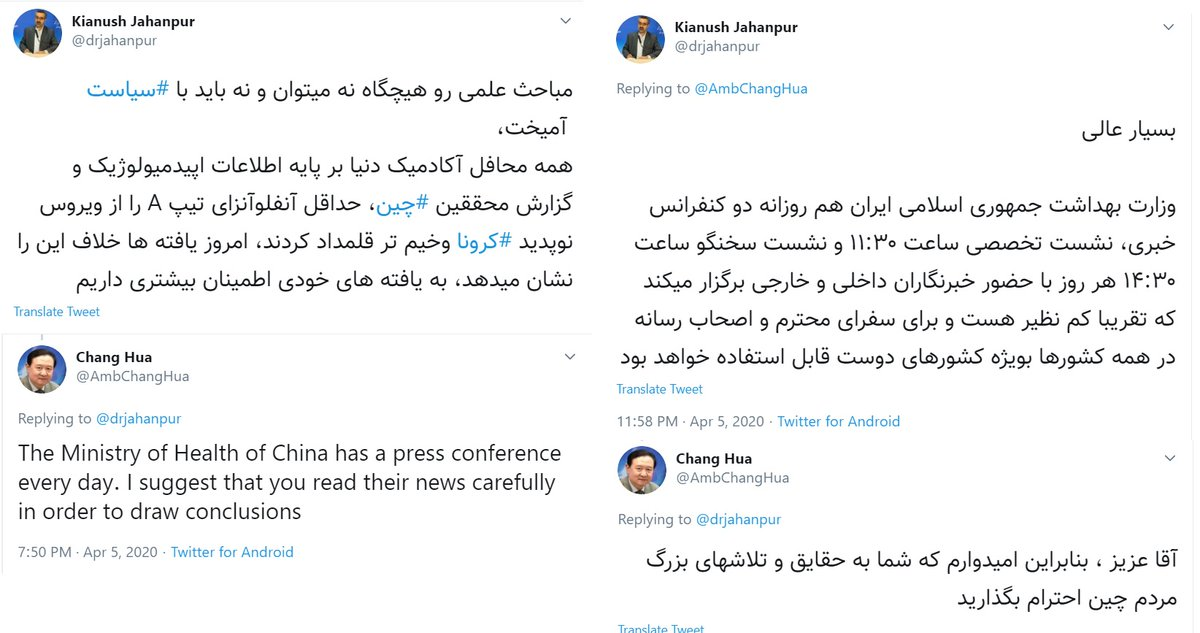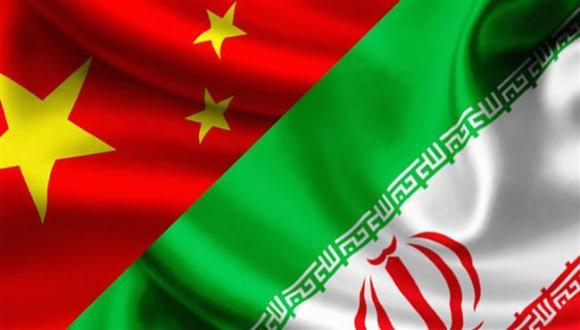From Red Dragon to Warrior Wolf: Iran-China Relations during the First Wave of Covid-19
Liora Hendelman-Baavur* and Shing Yau-Ma**
ACIS Iran Pulse no. 107 | June 14, 2020
The international circumstances created by the coronavirus in early 2020 opened a window of opportunity for Iran to buttress its bilateral relations with China using soft power strategies. The outbreak of the pandemic coincided with the landslide victory of the conservatives in the February parliamentary elections, which increased the influence of pro-Chinese factions in Iranian politics and IRGC ranks.
In the two years since the United States withdrew from the JCPOA and implemented a maximum pressure policy on the Islamic Republic, China’s position as Iran’s “lifeline” has strengthened (ACIS.IP.,106). The warming of the bilateral relations between the two countries led to an unprecedented joint naval exercise between Iranian, Chinese and Russian forces in the North Indian Ocean in late 2019. It also led China and Iran to update their strategic agreement for a period of 25-years, according to which Beijing will become more invested in developing Iran's infrastructure including oil, gas, petrochemicals and transportation sectors (Petroleum Economist, Sep.,3, 2019). China is not only an important strategic partner and Iran's largest oil customer, but it has also become a growing source of tourism to the Islamic Republic in recent years (Tehran Times, Dec. 4, 2019). As of June last year, Chinese tourists do not require a visa to enter Iran for stays of up to 21 days. To establish itself as a favorite destination for tourists from China, especially during the Chinese New Year which includes a two-week vacation, this year’s Magnificent Iran (ایران باشکوه) festival had been scheduled to take place in nine provinces across the Islamic Republic (Iran Tourism Experts Association). However, the expected wave of tourism from China in early February was replaced by a deadly surge of coronavirus that quickly spread from Wuhan to other centers in Euro-Asia, including Iran and beyond.

The outbreak of Covid-19 in Iran in early 2020 posed a complicated challenge for the Islamic Republic’s relationship with the People’s Republic of China. The epidemic, which soon became a pandemic (March 11), accentuated the enduring gap between various factions in Iran in terms of their stance on Beijing. Conservatives and hawkish factions among the Islamists in the political system, many of whom take pro-Chinese positions, tend to trust China, based on their belief that it naturally shares solidarity and historical, cultural and civilizational ties with Iran. They also perceive Tehran’s relationship with Beijing as based on mutual respect as well as economic interests in the framework of the “Belt and Road Initiative,” announced by President Xi Jinping in late 2013, to revive and restore the centrality of the ancient Silk Road.
Important components of the conservatives’ trust of China are fueled by Beijing’s passive support for the Iranian nuclear program, which it expresses through votes in the UN and other international organizations; and their shared frustration (together with Russia) with the US-led world order and in seeking ways to counterbalance American might. It is for good reason that political cartoons in Iranian media often represent China as an enormous red dragon confronting Western forces, especially Americans (Tasnim, Oct. 31, 2015). This amplifies the forces suspicious of the US. Although the source of Iranian regime’s wariness of the US is ideological, it is also rooted in the foreign policies of different US administrations toward Iran, of which withdrawal from the nuclear deal initiated by President Trump is a clear example.
At the same time, conservatives are over-cautious in their statements about Beijing’s attitude toward Muslim minorities within its borders. When Iranian officials are forced to address China’s policy towards its Uighur citizens in Xinjiang, they frequently return to the assertion that the West is overstating the oppression in the province because of political considerations, and that the claims are basically an attempt to undermine the image of the People’s Republic of China.
In contrast, members of the pragmatist and reformist camp are skeptical of China’s true aspirations, and many would have preferred to promote and develop relationships with Western countries. Although represenatives of this camp are not opposed to the benefits of Chinese investment and technology, they consider China an unreliable partner who serves only its own narrow interests, which could easily change. Other critics warn of the dangers of increasing Tehran’s dependence on Beijing and object to the barter between countries, which they claim exchanges valuable oil and energy resources for cheap goods of poor quality. Others go so far as to accuse China of duplicity, and indirectly supporting the US-led economic sanctions, with the goal of penetrating the Iranian market and establishing itself without any competition from the West (Markey, 136-7; Sherrill, 136-138).
Following the outbreak of the coronavirus, Western countries including the UK, Australia, and the US blamed China for hiding information about the outbreak and causing a global spread of a major epidemic (Newsweek, April 20). The multi-pronged accusation aroused in Chinese politics the particular historical memory of the "Eight-Nation Alliance," a multi-national military coalition that invaded China in 1900. The painful invasion, which aimed at suppressing the Boxer Rebellion of Imperial Guard soldiers and their supporters, who opposed the introduction of modernization into the country, eventually forced the Chinese Empire to pay heavy compensation to the US and its allies (BBC, April 17). On the backdrop of the international attack on its image, officials in the Iranian Foreign Ministry have shown extreme caution and have avoided making statements that might sound critical of China.
Instead, Iranian statesmen resorted to a soft-power strategy, released announcements of solidarity with the Chinese people, expressed support for Beijing’s efforts to combat the disease, and sided with Chinese sources claiming that the US was responsible for the pandemic, which it supposedly developed as a biological weapon to use against its rivals (VOA, March 24). Iranian Foreign Minister Zarif went even further, arguing that US "economic terrorism" supplanted by its "medical terrorism" are aimed at harming Iran, stopping humanitarian aid, and blocking its access to medicine and medical equipment (INA, March 7).
The Iranian press also repeatedly emphasized the gratitude and appreciation that China expressed in response to Iran’s gestures, stating that these efforts would further strengthen the deep relationship between the two nations. Meanwhile, Chinese Foreign Minister Wang Yi reportedly praised Iran as the first country to officially support China, and its foreign minister (Zarif) who welcomed the steps that Beijing took to fight the pandemic, stressing that they were far more successful and responsible than those taken by the US when dealing with Swine flu in 2009 (MashreghNews, April 6). Another gesture of solidarity with China in the fight against Covid-19 came from the Tehran City Municipal Authority on the evening of February 18, when they projected colorful slides with messages of international support with the city of Wuhan in particular and encouragement to China’s citizens in general, on the Azadi Tower in Tehran (Tehran Times, Feb. 19).

The Azadi Tower (formerly the Shahyad Tower) in Tehran, screened with messages of solidarity and sympathy with the people of China fighting Coronavirus epidemic, Feb., 18. Source: IRNA, Feb.,19, 2020
Iran’s support for China was not purely formal in nature but went beyond statements and symbolic gestures, practically in what was later called the “Face-Mask Diplomacy.” In early February, Tehran donated one million surgical masks to Beijing, and expressed its intention to donate another 2 million, despite warnings from the local medical equipment manufacturers association that Chinese merchants had already purchased the entire reserve of masks in Iran. Parallel to Iran's generous donation, the association continued to warn that there could be a severe shortage in the local market, as indeed happened two weeks later (Radio Farda, Feb. 3).
Iranian authorities officially announced the outbreak of the Covid-19 within Iranian borders on February 19, concurrent with confirmation that two people had succumbed to the disease. The official announcement of an outbreak in Qom, which has approximately 1.2 million residents and is the center of Shia religious education in Iran, sparked widespread public outrage at the conduct of President Hassan Rouhani and his government. Strong criticism, later dubbed by the Iranian media as “Qom-phobia” (قم هراسی), lambasted the government for failing to impose an immediate and complete closure on the city, and the lack of a clear policy ordering the closure of its mosques and religious seminars (Tabnak Qom, March 29). Ministry of Health spokespeople and local health officials were far less diplomatic than their counterparts in the Foreign Ministry. Their statements about China put the Islamic Republic’s damage control mechanism into overdrive, and critical or negative accounts that might offend Beijing were censored as part of the fight against “false news” about coronavirus.
Initial estimates by Health Ministry spokespeople attributed the outbreak of Covid-19 to Chinese construction workers of the solar power plant in Qom, while other publications claimed that a local businessman had traveled to China returned to Iran while infected and subsequently died as the source. In an interview published on February 24 in the Iranian Student News Agency, Dr. Mohammad Hossein Bahraini, head of the Medical Science University of Mashhad, was quoted saying “The reason for a high death toll due to coronavirus was the presence of 700 Chinese religious students in spiritual schools in Qom”. The report was soon removed from the internet, and replaced with a denial stating that the interview never happened (Hawzah-news., March 24).
The following month, state-controlled agencies reported that early cases of the virus were also detected in Gilan Province, probably originating with Iranian students returning from China, and that the publications that referred to Qom as the epicenter of the Coronavirus in Iran were baseless because there were no Chinese students in the city (Tabnak Qom, March, 29). The Director General of Iran’s religious seminars, Ayatollah Ali-Raza Arafi, similarly stated that the outbreak of the epidemic did not originate with Chinese students studying in the international program, because only two students from China joined the program last year, and they were in quarantine (ABNA, Feb. 26).
In this context, it is worth noting that the number of Iranian students studying in China is significantly higher than the number of Chinese students reportedly studying in Iran. Many of latter are from Hui Muslim ethnic minority, who come from Ningxia and Gansu, in northwestern China (The Paper, March 14, 2019). Last year, the Ministry of Science reported that approximately 130 Chinese students studied in Iran, compared to 2,500 Iranian students in China (IRNA, May 5, 2019; Fars, Feb. 8, 2020), in addition to the academic and cultural activities of the Confucius Institute at Tehran University (since 2009) and Mazandran University (since 2019). Many Chinese students and citizens staying in Iran returned to China or were evacuated as coronavirus spread (ChinaNews, March 13), just as a similar airlift evacuated Iranian students from Wuhan in early February (Hamshahri, Feb. 18).
Another wave of criticism was sparked against Mahan Air, a privately owned airline that serves the IRGC, for flying at least 55 flights to Beijing, Shanghai, Guangzhou and Shenzhen during February, despite Interior Minister Abdolreza Rahmani Fazli announcing in late January that Iran’s airspace was closed to flights to and from China (ISNA, Feb. 4; Radio Farda, March 13). Notwithstanding public outrage over Mahan Air’s mysterious flights, and accusations that the regime prioritizes ideology over public health, when Iran became the epicenter of coronavirus in the Middle East, China was the first country to send medical personnel and generous shipments of medical and protective equipment (PressTV, Feb. 29). Users of Weibo, the Chinese micro-blog service (similar to Twitter), worked to recruit businesses and raise funds to help the people of Iran fighting the pandemic. China also provided Iran with comprehensive information about ways to contain coronavirus, and instructions for setting up an improvised medical center in the Mall of Iran, the country’s largest shopping center, using the model of Huoshenshan Hospital, which was built in only 10 days to treat Covid-19 patients in Wuhan (People’s Daily).
Iranian authorities’ efforts to minimize the critical tone toward China at home reached their breaking point in early April following a heated exchange between the Iranian Ministry of Health and the Chinese Embassy in Tehran on Twitter. On April 5, during his press briefing on Covid-19, Kianoush Jahanpur, a spokesman for the Iranian Ministry of Health, commented that China’s initial information on the disease was “a bitter joke.” He went on to claim that the information about the deadly virus that China provided to international research laboratories was misleading and caused governments around the world to underestimate the severity of the disease (as if it were a Class A influenza with a low rate of contagion), and therefore the announcement that the People’s Republic was able to curb the spread of the virus within two months should also arouse suspicion (Asr-e Iran, April 6).
China’s response to this criticism was quick to follow, in the form of a “wolf warrior strategy,” when Ambassador Cheng Hua, tweeted a recommendation that Jahanpur should follow the daily briefings from the Chinese Ministry of Health carefully, and draw the accurate conclusions (rather than relying on rumors). The Chinese Embassy in Tehran filed a complaint with the Iranian Foreign Ministry, and in another tweet, Cheng Hua reminded Jahanpur that he should respect the truth and the great efforts of the Chinese people. According to some pundits and analysts, the ambassador’s response points to a presumed transition of Chinese diplomacy, "from being conservative, passive, low-key to assertive, proactive, and high profile" (Think China, May 4).

The exchange of tweets (removed by now from twitter) that sparked a diplomatic row, April 5, 2020
In the Chinese media, this transition in Chinese foreign policy is identified with the impact of the 2017 action movie Wolf Warrior II (the sequel of Wolf Warriors, 2015), which became with encouragement from the authorities one of the country’s biggest blockbusters. The plot follows a discharged soldier of China’s Special Forces, Leng Feng, who heads to rescue Chinese nationals in Africa and finds himself protecting a medical team in search of a cure for a plague-stricken population, while fighting local arm dealers and insurgents. Both films abound with nationalist propaganda and patriotic messages. Their main thrust is that "those who offend our Chinese nation will be punished no matter how far away they are," and that China is a responsible and generous power, and should be given the proper respect (GlobalTimes, Jul.,30,2017).
Domestically, the diplomatic incident between the Chinese Embassy and the Ministry of Health prompted vigorous reactions from representatives of conservative factions in Iranian media. Hassan Suleimani, editor-in-chief of Mashregh News Agency, wondered aloud – on his Twitter account – whether Jahanpur became a spokesperson for Trump or Israel (Twitter, April 6). Hussein Delirian, a former editor at the Tasnim News Agency, identified with IRGC, even called for his dismissal from the Ministry of Health. On the other hand, politicians Ali Motahhari and Mahmoud Sadeghi, reformist conservatives who were disqualified from running in the February 2020 parliamentary elections, supported the Ministry of Health’s stand, condemned Jahanpur’s critics, and pointed to the condescending tone of the Chinese ambassador. Motahhari, who for the past three years has been a sharp critic of the law-enforcement agencies’ use of force, called on the Foreign Ministry to summon the Chinese ambassador for a hearing. He further opined that the purpose of the campaign against the US was not to develop complete dependence on China (Hamshahri, April 9).
Foreign Ministry spokesman Abbas Mousavi tweeted a palliative message, noting that China’s courage, commitment and professionalism was appreciated and emphasized Iran’s gratitude for Beijing’s generous assistance, using the hashtag #Strongtogether (RFERL, Apr. 6). A month later, Tehran was able to demonstrate its gratitude by supporting Beijing’s decision to promulgate the new Hong Kong National Security Laws, which Western experts believe will significantly increase the impact of the Communist regime on this special administrative region (ILNA, May 25). As for Jahanpur, he was eventually forced to retreat and praise China's coronavirus efforts, and early in June a new spokesperson was appointed by the Ministry of Health to replace him (Radio Farda, Jun.,9).
The international circumstances created by the coronavirus in early 2020 opened a window of opportunity for Iran to buttress its bilateral relations with China using soft power strategies, on the backdrop of increasing influence of pro-Chinese factions in Iranian politics and the IRGC. However, it is highly doubtful that these developments will overcome the factional dispute between the "Sinophiles" in the higher echelons of decision-making in Tehran and the reformists and pragmatists, who prefer to move closer to the West, or conversely have a dramatic effect on Beijing’s foreign policy framework.
* Dr. Liora Hendelman-Baavur is the Director of the ACIS at Tel Aviv University; editor of the anthology Iran Then and Now: Society, Religion & Politics (Hakibbutz Hameuchad, 2017) and author of Creating the Modern Iranian Woman: Popular Culture between Two Revolutions (Cambridge University Press, 2019).
** Shing Yau-Ma is an MA student at TAU's International Program of Security and Diplomacy Studies and a Research Assistance at the ACIS International Internship Program.
T h e A l l i a n c e C e n t e r f o r I r a n i a n S t u d i e s ( A C I S )
Tel Aviv University, Ramat-Aviv 61390, Tel Aviv P.O.B. 39040, Israel
Email: Irancen@tauex.tau.ac.il; Phone: +972-3-640-9510
F a x : + 9 7 2 - 3 - 6 4 0 - 6 6 6 5
ACIS Iran Pulse No. 107 ● June 14, 2020
©All rights reserved


